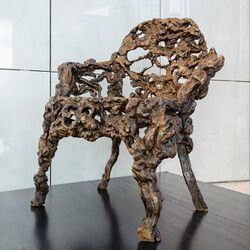Engineering:Root carving
Root carving is a traditional Chinese art form. It consists of carving and polishing tree roots into various artistic creations.
History
Carving of roots has been practiced since very early times; like many other artistic crafts, root carvings were originally produced in a primitive manner. The earliest root carvings are “辟邪” and “角形器”, showing up in the Warring States period.
In the Sui and Tang dynasties, root carving works not only prevailed in folk, but they were also cherished by the governing class. In the Tang dynasty, people laid emphasis on the natural forms of roots, cleverly taking advantage of the effect of corrosion and moth-eaten.
In the Song and Yuan dynasties, the art of root carving not only developed in the court and folk, but also appeared in grottoes and temples. Roots were used to carve the statues of the Buddha, always comparing favorably with the clay.
Features
Root carving is widely said to preserve natural beauties present in the roots already. Ancient and modern artists alike create lifelike, vivid works with a special technique using expression based on the roots' natural forms.
Root carving is different from engraving, as it combines peculiarity with ingeniousness. Although its aesthetic principals share common ground with engraving, at the same time they are applied uniquely. The common ground is that they share expressive techniques of wood carving, sculpture, stone carving and so on, overcoming weaknesses by acquiring other's strong points. The difference lies in the natural shape of roots. During the creative process, root carving mostly maintains the natural form of the root, adding some artificial polishing. In other words, root carving is guided by the inherent qualities of the root, rather than by strictly carving images.[1][2]
Necessities
This section contains wording that promotes the subject in a subjective manner without imparting real information. (May 2015) (Learn how and when to remove this template message) |
Creative effect achieved from the same material can vary from artist to artist. Within the field, three factors are generally considered of major importance.
- Uniqueness of the root - To some degree, root carving is an act of discovery. Finding and working with a unique root is half of the task and requires experience and a keen aesthetic vision.Template:Or-inline
- Cultural foundation - Rich cultural foundation, referring to the overall creative process, highlights the natural beauty of the root.Template:Or-inline
- Craftsmanship - The natural beauty of roots can be realized from a fertile imagination and a high degree of composition.[3][4][5][6][7][8][9][10][11]
References
- ↑ "根雕艺术的特点". News.genpen.com. 2010-03-07. http://news.genpen.com/genyi/jieshao/9661.html.
- ↑ "根雕艺术发展史". Gzzhuhai.com. 2011-06-23. http://gzzhuhai.com/news-22.aspx.[yes|permanent dead link|dead link}}]
- ↑ "根雕艺术(三)图1_树木果实_天极图片". Pic.yesky.com. 2010-12-05. http://pic.yesky.com/sucai/szwfj/shumumo/238/520738.shtml.
- ↑ "根雕艺术(三)图2_树木果实_天极图片". Pic.yesky.com. 2010-12-05. http://pic.yesky.com/sucai/szwfj/shumumo/238/520738_2.shtml.
- ↑ [1][|permanent dead link|dead link}}]
- ↑ "用树根雕塑人生-健康平安网". Jkpa.net. 2010-05-11. http://www.jkpa.net/news_show.php?nid=740l.
- ↑ "缅甸黄金樟树瘤 让根雕艺术焕发无穷魅力 树瘤- 红木知识、红木种类". Sh1800.net. 2011-08-23. http://www.sh1800.net/hongmu/woodintro/960.htm.
- ↑ "根雕艺术你了解吗 - 头头外挂网". Tynet.gov.cn. http://www.tynet.gov.cn/HXTou/gdysnljm_4/.
- ↑ "四川芦山第四届根雕艺术节开幕_四川新闻网-雅安频道". Ya.newssc.org. 2011-03-25. http://ya.newssc.org/system/20110325/001211581.html.
- ↑ "嵊州新闻网-中国根雕艺术精品展". Sznews.zjol.com.cn. http://sznews.zjol.com.cn/sznews/ztpd/gdysz/index.shtml.
- ↑ "根雕艺术概述". Craaw.com. http://www.craaw.com/ljrw1.htm.
External links
 |




